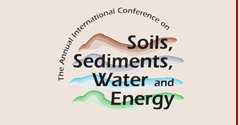Abstract
A binary system containing water and different water-soluble ionic liquids (WSILs) were considered for extraction of three typical endocrine disruptor chemicals (EDCs), 17β-estradiol (17β-E2), bisphenol A (BPA), and nonylphenol (NP), from three model sediments. Imidazolium and pyridinium based ionic liquids with different anions (tetrafluoroborate or chloride) were selected as representative WSILs to assess the extraction of EDCs from different sediments by the binary system containing water and WSILs at different molecular ratio. Comparing with extration of EDCs by water, the presence of 1-butyl-3-methyl imidazolium tetrafluoroborate ([bmim]PF4) or N-butyl-3-methyl pyridinium tetrafluoroborate ([bmpy]PF4) in the binary system at low molecular ratio could decrease the extraction of EDCs. However, at high molecular ratios, WSILs in binary system significantly increase the extraction of EDCs, especially for those from sediments with high organic matter content. At a molecular ratio of 5: 5 (WSIL: water), extraction by the binary system containing [bmim]PF4 was more efficient than that by [bmpy]PF4. However, at a molecular ratio of 1: 9, contrary results were gained. Cation-π, π-π, and hydrogen bond interaction of phenolic hydroxyl and “-N=C(H)-N-” were proposed to be the major interactions between WSILs and EDC molecules, while these interactions were greatly inhibited when water molecule presented in the binary system at high ratio. And also the adsorption of WSILs on sediments could affect the extraction efficiency when they presented at low ratio. At the same molecular ratio, the presence of [bmim]PF4 and 1-butyl-3-methyl imidazolium chloride ([bmim]Cl) resulted in similar extraction efficiencies, which might suggest that anions of WSILs play minor role for extraction of EDCs in this study.
Recommended Citation
Wang, Lei; Zhang, Guohua; Sun, Hongwen; Dai, Shugui; and Tu, Teng
(2010)
"The Capability of Binary System Containing Water-Soluble Ionic Liquids for Typical Endocrine Disruptor Chemicals Extraction from Sediments,"
Proceedings of the Annual International Conference on Soils, Sediments, Water and Energy: Vol. 15, Article 21.
Available at:
https://scholarworks.umass.edu/soilsproceedings/vol15/iss1/21
